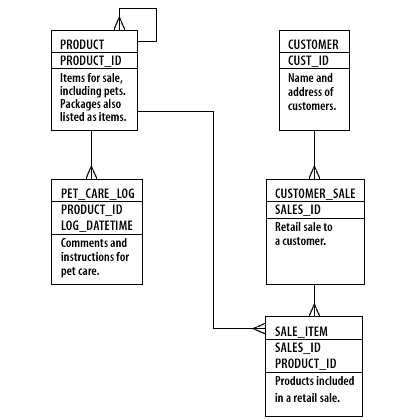| Lesson 3 | Database course project |
| Objective | Describe the pet store schema and assess your current SQL skill level |
What will you do with the course project?
The course project, a pet store, acts as the basis for many of the exercises and examples. By the end of the course, you will have completed these kinds of tasks for the course project:
Imagine you own an online pet store called House-O-Pets.com. You use an Oracle database schema to keep track of inventory, customers, and customer purchases. Because you are selling real live pets, you have a real pet store as well, with several employees to take care of the animals. You get orders from customers all around the country. In addition, you have rabbits, puppies, kittens, fish, and birds in your store.
Your inventory includes pet supplies for all these animals. Customers can purchase any item individually. In addition, two packages that include a set of related items sell at a discount. For example, the Puppy Package comes with a puppy (of course), dog food, a chew toy, and a dog collar. To help your employees care for the animals, your database contains a pet care log where any employee can record information about the animals, such as how often to feed the birds.
- Build a SQL*Plus report that shows the history of purchases at the pet store.
- Create queries to display the pet care instructions for various animals in the store.
- Add a new column to a table when new data must be stored.
- Assign read and write privileges to different employees.
- Update data to reflect the latest inventory count.
Imagine you own an online pet store called House-O-Pets.com. You use an Oracle database schema to keep track of inventory, customers, and customer purchases. Because you are selling real live pets, you have a real pet store as well, with several employees to take care of the animals. You get orders from customers all around the country. In addition, you have rabbits, puppies, kittens, fish, and birds in your store.
Your inventory includes pet supplies for all these animals. Customers can purchase any item individually. In addition, two packages that include a set of related items sell at a discount. For example, the Puppy Package comes with a puppy (of course), dog food, a chew toy, and a dog collar. To help your employees care for the animals, your database contains a pet care log where any employee can record information about the animals, such as how often to feed the birds.

Below is an analysis of the tables and their relationships: Tables in the Database:
-
PRODUCT
- Primary Key:
PRODUCT_ID - Description: Stores details of items for sale, including pets and packages that are listed as items.
- Primary Key:
-
PET_CARE_LOG
- Primary Key: (
PRODUCT_ID,LOG_DATETIME) - Foreign Key:
PRODUCT_ID(references PRODUCT table) - Description: Logs comments and instructions for pet care.
- Primary Key: (
-
CUSTOMER
- Primary Key:
CUST_ID - Description: Stores customer names and addresses.
- Primary Key:
-
CUSTOMER_SALE
- Primary Key:
SALES_ID - Foreign Key:
CUST_ID(references CUSTOMER table) - Description: Represents a retail sale made to a customer.
- Primary Key:
-
SALE_ITEM
- Primary Key: (
SALES_ID,PRODUCT_ID) -
Foreign Keys:
SALES_ID(references CUSTOMER_SALE table)PRODUCT_ID(references PRODUCT table)
- Description: Stores products included in a specific retail sale.
- Primary Key: (
Relationships:
-
PRODUCT ↔ PET_CARE_LOG (1-to-Many)
- Each product (pet) can have multiple pet care log entries.
- A pet care log entry belongs to a specific product.
-
CUSTOMER ↔ CUSTOMER_SALE (1-to-Many)
- A customer can make multiple purchases.
- Each sale is associated with exactly one customer.
-
CUSTOMER_SALE ↔ SALE_ITEM (1-to-Many)
- Each sale can include multiple products.
- A sale item is associated with a specific sale.
-
PRODUCT ↔ SALE_ITEM (1-to-Many)
- A product can be included in multiple sales.
- A sale item corresponds to a specific product.
Summary:
- The PRODUCT table stores all items, including pets and packages.
- The PET_CARE_LOG table tracks care instructions for pets.
- The CUSTOMER table holds customer information.
- The CUSTOMER_SALE table records retail transactions.
- The SALE_ITEM table links products with sales.
This ERD represents a structured approach to managing products (including pets), sales, and customer transactions in a pet store database system. Database Schema consisting of PRODUCT, CUSTOMER, PET_CARE_LOG, CUSTOMER_SALE, AND SALE_ITEM tables.
The pet store schema shown above contains a set of related tables. See the
In the next module, you will learn about the Oracle environment.
epet_data.doc files that you downloaded earlier for a complete listing of each table’s columns and data.
In addition to the five tables, there is a view called MONTHLY_SALES that lists total sales for each month/year combination.
There is also a sequence called PETSTORE_SEQ that generates unique primary key values for the PRODUCT,
CUSTOMER, and CUSTOMER_SALE tables. In the next module, you will learn about the Oracle environment.